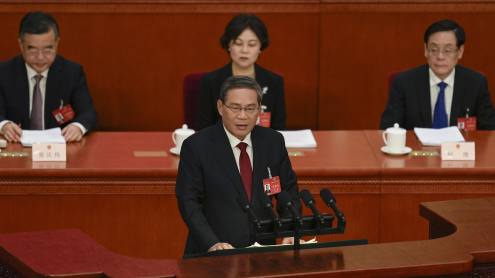When Banco de Credito del Peru (BCP), the South American country’s largest bank, was bidding for the mandate to list the shares of a long-standing client, the bank’s chief executive, Walter Bayly, thought the task would be a relatively simple one. It turned out to be anything but, as international rivals offered the prospective issuer not only the opportunity to float in Peru, but also in Chile and Colombia. BCP won the deal, but the battle it faced made it clear that issuers and deal markets do not look at Peru in isolation, but as part of a promising Andean region.
“Both on the issuer and the investor side, it is very clear that the market is very much integrated already,” says Mr Bayly. The example shows just how crucial BCP’s regional strategy is. The lender has acquired Chilean investment bank IM Trust in April this year and Colombian investment brokerage Correval in November 2011.
Andean expansion
This expansion of Peru’s banks and businesses runs alongside the strengthening of the 'MILA project', the stock exchange integration between Peru, Colombia and Chile, which was created more than a year ago. Jose Antonio Blanco, the president of Peru's central securities depository, Cavali, has been closely involved in the development of MILA, and despite the exchange not quite performing as well as had been hoped – continued uncertainty in the global markets has hindered its growth – MILA has shown encouraging signs. “We have seen that Chilean investments in Peru have doubled and the number [of investors] has grown by 35%, while the number of Colombian investors has grown by 100%,” he says, while acknowledging that these figures are from a very low base.
BCP itself has also benefited from the growing interest in Peruvian assets and the expanded firepower of Latin America’s investors. The bank’s latest debt issuance, in September last year, did not receive a particularly warm reception in Europe, where investors were preoccupied with other matters, something that Mr Bayly says did not come as a surprise. However, the $350m subordinated notes, yielding 6.875%, were nonetheless successfully placed, despite the limited 14% allocation to Europe. The success of the issue was largely down to the fact that 40% of the bookings came from Latin America. “That number was traditionally 20%,” says Mr Bayly.
Peru gets active
BCP is the largest and most active Peruvian issuer but many other local companies have increased in size and are getting ready to tap the international capital markets – encouraged by the alternatives offered by livelier Latin American investors. Many companies in Peru have seen their turnovers expand tenfold over the past decade and their requirements are becoming too large for Peru’s capital market to absorb, meaning that these companies have increasingly had to look abroad.
“Right now, many of these companies already have turnovers of more than $1bn,” says Mr Blanco, who also heads Citi’s operations in the country. “The capital expenditure plans and projects that they have are no longer what we used to see in the 1990s, of between $20m to $50m; now they talk about planned expansion, even regional expansions, that will demand between $300m to $1bn in most of the cases.”
Mr Blanco expects a record number of international issuances from out of Peru to have been placed in the second quarter of this year. The local capital market is liquid but not as deep as larger issuers need it to be. Companies that would want to raise $300m or $400m will not be able to do it in one tranche, say arrangers, though they can easily execute this on the international market. And it is not only the larger size of their notes that make Peruvian companies a good match for international investors; local corporate governance practices have also been improving over the years, providing international investors with the kind of information and management environment they demand.
We have seen that Chilean investments in Peru have doubled and the number [of investors] has grown by 35%, while the number of Colombian investors has grown by 100%
“Not only have we seen companies growing at multiples of gross domestic product [GDP] growth, but those companies have also professionalised their management and have incorporated best practices related to corporate governance,” says Mr Blanco. “Those companies are ready to tap the international capital markets.”
Heavy equipment company Ferreyros is one of those issuers and is preparing to go to foreign investors with its first international bond. Mariela Garcia de Fabbri, the firm’s chief executive, says: “We have very good corporate governance [at Ferreyros] but we didn’t have anything written down [until recently]. Right now, many [people] ask us for those documents [so that they can] replicate them in their companies.” Ms Garcia de Fabbri says that going to international markets will give Ferreyros the chance of a longer maturity, of between seven to 10 years.
Longing for longer
Longer maturities and the ability to absorb larger than usual tranches are a key aim for Peru’s authorities. The country’s finance minister, Luis Castilla, is aware that the local capital markets need to catch up with the development of the country’s businesses, and match what other countries in the region are already offering.
“We are aware that [Peruvian] capital markets are shallow in comparison to other countries,” says Mr Castilla. “There is plenty of room for growth, and we need to do several things. One is reducing the cost of issuance to be able to reduce entry barriers and have more firms of smaller size participating actively. [We need] to facilitate the creation of more investment alternatives, mutual funds, investment funds, [and we need] to be able to tap on those savings that we have accumulated [We also need] to work on corporate governance.”
A turning point for issuers and investors alike will come with the introduction of a new, strong corporate governance code, which is expected to be brought into play at the end of 2012. Speaking at a conference in London in April, Lilian Rocca, the chairman of Peru’s Superintendency of the Securities Market (SMV), was keen to highlight the organisation’s continued efforts in this area.
These efforts have been reflected in an improved stock market performance, according to Peru’s central bank governor, Julio Velarde. “Some of the companies that have [enjoyed] stronger growth in the price of their shares are those with better governance,” he says, adding that the market has also benefited from better governance and management on the investor side, particularly in the pension funds sector.
Domestic demand
Peru's banks will welcome such developments, as well as a large number of corporate clients ready to tap the local and international capital markets. But there are still plenty of business opportunities in the country's domestic market.
Peru’s GDP grew by 6.92% in 2011, outperforming the Latin American average, largely thanks to its improved domestic demand. Retail sales increased 10.34% on 2010, according to research firm Roubini Global Economics. Imports of consumption goods grew, by 14.52%, and vehicles sales were up 26% – all signs that reflect the expansion of Peru’s middle class. Further, according to Peru’s national statistics office, INEI, poverty rates have almost halved between 2004 and 2010.
This trend has continued in 2012 too, with GDP growth of 5.55% in March compared to the same month in 2011, the 31st consecutive month of economic growth, and a result of continued internal demand. The International Monetary Fund expects the Peruvian economy to expand by 5.5% in 2012 and 6% in 2013.
It is estimated that of the 10 million so-called economically active individuals living in urban areas – individuals who earn above the minimum wage – only 6 million are customers of a financial institution. “The banks’ [problem] is that we do not have something that is interesting to those [4 million] individuals,” says Mr Bayly. “It is a combination of having the right products, distribution channels and prices so that we have something appealing to those individuals. How do we develop that combination? That’s the big challenge for banks now.”
Banking growth
Peru's banking sector has grown even faster than the country’s economy, at about 2.5 times the growth of its GDP over the past decade, and it is expected that banks will expand their business between 15% and 18% in 2012, having displayed an average yearly growth of 20% for the past 10 years, say bankers.
In 2011, the country’s top five banks all strengthened and developed their businesses. Average Tier 1 capital improved among the largest five banks by more than 20%, led by Interbank’s 33.79% expansion. Their assets grew on average by more than 11%, with BBVA Banco Continental experiencing the highest rise of 16.5%. Among the big five, profits grew by an average of nearly 18%, with BCP showing an impressive growth of 28.67%.
But with such growth comes structural challenges, ranging from finding funding sources to coping with the lack of a sufficiently wide banking network. “This growth poses a lot of challenges to the financial system,” says Mr Bayly. “One is infrastructure. By any measure that one can think of, the level of infrastructure that we will have to build to deal with this growth is tremendous – not only branches, but also ATMs, internet banking, mobile banking and so on.” He adds that BCP is investing $100m a year to fill this gap.
The fragmented nature of Peru's local banking system means that different institutions are leaders in different markets – aside from BCP, Interbank and Falabella are strong competitors in the credit card business; microfinance specialist Mibanco leads in that sector; while international names such as Morgan Stanley, JPMorgan and Citi dominate the investment banking space. But the larger pool of potential retail customers means that even traditionally wholesale institutions are looking to create or strengthen their presence in the retail sector, according to Citi’s Mr Blanco, thus increasing competition in that space.
Staffing has also become an increasingly problematic aspect as banks need a larger and more skilled workforce to expand their business. This is a challenge for a country which lags behind other Latin American countries when it comes to standards of education. According to the 2009 PISA study, which measures students’ performance in certain areas, Peru lagged many of its regional peers, scoring nearly 25% lower than Uruguay in mathematics, and almost 30% lower than Chile on reading ability.
The labour pool of highly skilled workers is limited and the larger the financial institution, the bigger the recruitment headache. “Because of growth and the normal rotation of certain positions, at BCP we have to hire between 5000 and 6000 people every year, and the ratio of people you have to interview is normally seven to one,” says Mr Bayly. “So we interview 35,000 people every year, and we are starting to see a shortage of qualified people [suitable for] the banking sector.”
Peru displays the typical opportunities and challenges of a fast-growing market. What differentiates the country is that its economic growth has been sustained over a number of years, its macroeconomic indicators are promising and there is a clear plan, both in the public and private sectors, to support the funding needs of its equally fast-growing businesses.













